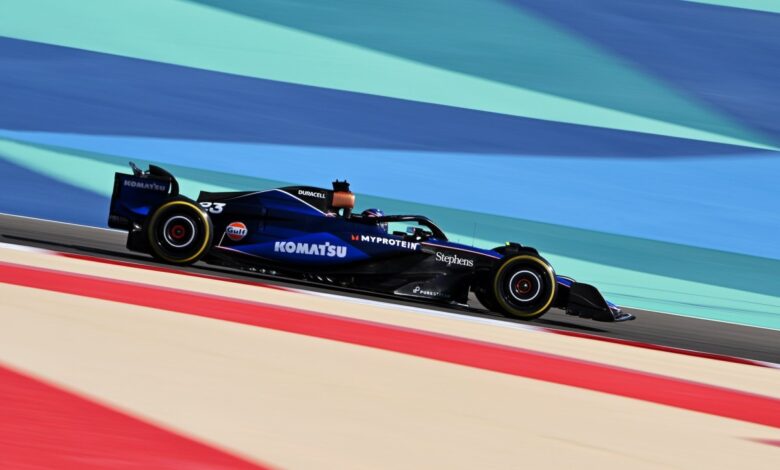How Neural Idea’s aerodynamic AI is shaping Formulation 1

[ad_1]
It’s a protracted manner from pedal bikes to Formulation 1. However that’s exactly the quantum leap that AI-based startup Neural Idea and its co-founder and CEO, Pierre Baqué, made in simply six years.
In 2018, the corporate’s fledgling software program helped develop the world’s most aerodynamic bicycle. Right this moment, 4 out of 10 Formulation 1 groups use an evolution of that very same know-how.
Alongside the way in which, Baqué’s firm picked up contracts with aerospace suppliers like Airbus and Safran, earning a $9.1 million Series A raise in 2022. Now at 50 workers, Switzerland-based Neural Idea is working towards a Sequence B spherical whereas its software program helps historic F1 groups like Williams Racing discover their manner again to the highest of the world’s premiere type of motorsport.
Nonetheless, the place Formulation 1 automobiles depend on 1,000-horsepower hybrid V6 engines, Baqué’s first sensible software of the know-how was human-powered.
Pedal energy
In 2018, Baqué was learning on the École Polytechnique Fédérale de Lausanne’s Laptop Imaginative and prescient Laboratory, engaged on making use of machine studying strategies to three-dimensional issues.
“I used to be put in touch with this man who was main this workforce, designing the sixth or seventh era of motorbike, and their objective was to interrupt a world file of bicycle pace,” Baqué stated. That man was Guillaume DeFrance, and the workforce was IUT Annecy from the Université Savoie Mont Blanc. The biking workforce had already gone by way of a half-dozen iterations of motorbike designs.
“Two days later, I got here again to him with a form that was virtually wanting like the present world file holder,” Baqué stated. Impressed, the workforce requested for extra iterations. The outcome was, per Baqué, “probably the most aerodynamic bike on the earth in the meanwhile.”
That’s a robust assertion, nevertheless it’s backed up by a number of world information earned in 2019. We’re not speaking about aerofoil-shaped downtubes or dimpled rims to scale back drag. This bike is totally shrouded, with the bike owner sweating away in a composite cocoon, utterly sheltered from the wind.
The core know-how is a product referred to as Neural Idea Form, or NCS. It’s a machine-learning-based system that makes aerodynamic solutions and proposals. It suits into the broad subject of computational fluid dynamics (CFD), the place extremely educated engineers use superior software program suites to run three-dimensional aerodynamic simulations.
CFD is way sooner than carving bodily fashions and throwing them into wind tunnels. Nonetheless, it’s additionally massively system-intensive and largely reliant on human beings making good choices.
At its core, NCS helps engineers keep away from potential aerodynamic pitfalls whereas pushing them into instructions they may not have thought of. In “co-pilot mode,” an engineer can add an present 3D form, offering a place to begin, for instance.
NCS will then dig into its neural community to recommend enhancements or modifications, doable paths in a 3D sport of choose-your-own-adventure. The human engineer then picks probably the most promising solutions and runs them by way of additional testing and refinement, iterating their method to aerodynamic glory.
Not simply “dishonest the wind”
NCS is beneficial not only for racing but in addition within the automotive and aerospace industries. “The trail to vast adoption in these sorts of firms is gradual,” Baqué stated of working throughout the considerably conservative aerospace business. “That’s how we began working extra with the automotive business, the place the wants are a bit extra burning, they usually’ll be fast to vary.”
Neural Idea secured contracts with a number of international suppliers, together with Bosch and Mahle. Aerodynamics is more and more key within the automotive world, with producers trying to find ever-more aerodynamic automobiles that ship the best doable vary from a given-sized battery pack.
Nevertheless it’s not all about dishonest the wind. NCS can be utilized in growing issues like battery-cooling plates that, if made extra environment friendly, can maintain the battery at its optimum temperature with out sapping an excessive amount of vitality within the course of. “There are large positive aspects that may be made,” Baqué stated, which means but extra vary.
Whereas the final word proving floor for these applied sciences is all the time the street, the final word laboratory is Formulation 1. A world motorsports phenomenon since 1950, F1 is presently experiencing an unprecedented wave of recognition.
The facility of Netflix
The Netflix collection “Formulation 1: Drive to Survive” has introduced the joy of F1 to an entire new viewers. Whereas that collection focuses on inter-team politics and drama, success on the observe has way more to do with aerodynamics. That’s the place Neural Ideas is available in.
Baqué began watching Formulation 1 earlier than Netflix was even a twinkle in Reed Hastings’ eye. “I all the time watched, because the time of David Coulthard and Michael Schumacher.”
Right this moment, elements developed with help from his firm’s software program are working on this pinnacle of world motorsport. “It’s an excellent, nice sense of accomplishment,” Baqué stated. “After I began the corporate, I used to be seeing this as a landmark. Not solely Formulation 1, however simply to have elements that had been designed with the software program on the street. And, yeah, each time that this occurs, it’s an excellent, nice feeling.”
Formulation 1 can be a particularly secretive sport. Of the 4 groups that Neural Idea works with, just one was prepared to be recognized as a consumer, and even it was fairly tight-lipped about the entire course of.
Williams Racing is likely one of the most storied groups in Formulation 1. Based again in 1977 by racing legend Frank Williams, his workforce was so dominant within the Nineties that it received 5 constructors’ world championships, together with three in a row from 1992 to 1994.
However like in most sports activities, success is cyclical for Formulation 1 groups, and proper now, Williams could be very a lot in a rebuilding section. The workforce completed useless final within the 2022 season, rising solely to seventh final yr.
NCS is likely one of the instruments serving to Williams regain its aggressive edge. “We use this know-how in numerous methods, a few of which enhance our simulation, and different strategies that we’re engaged on will assist ship higher outcomes first-time in CFD,” stated Williams Head of Aerodynamic Know-how Hari Roberts.
Once more, CFD simulations are time-intensive and dear, a scenario compounded by Formulation 1 rules that restrict a workforce’s capacity to check. Bodily time within the wind tunnel is closely restricted, whereas every workforce additionally has a restricted finances for computing time they will use to develop their automobiles.
Any instrument that may assist a workforce get its aerodynamic designs in form shortly is a possible benefit, and NCS could be very fast certainly. Baqué estimated {that a} full CFD simulation that usually takes an hour would take as little as 20 seconds by way of NCS.
And, since NCS isn’t working precise physics-based calculations however making AI-driven guesses based mostly on its community of aerodynamic learnings, it’s largely exempt from F1’s draconian restrictions. “Something we are able to do that enables us to extract extra information and subsequently extra efficiency from every CFD and wind tunnel run provides us a aggressive benefit,” Roberts stated.
However the groups nonetheless must pay for it. Baqué stated that NCS prices range relying on the scale of the workforce and sort of entry, however usually, it’s within the vary of €100,000 to €1 million per yr. Contemplating F1 groups additionally function beneath a $135 million annual price cap, that’s a considerable dedication.
Williams’ Roberts wasn’t prepared to level to any particular elements or lap time enhancements due to NCS software program however stated it has affected their automobile’s efficiency: “This know-how is used as a part of our toolset for growing the automobile aerodynamically. We, subsequently, can’t attribute lap time on to it, however we all know that it helps our correlation and the pace at which we are able to examine new aerodynamic circumstances.”
Past aerodynamics
The ceaseless march of AI received’t cease there. There may be discuss of synthetic brokers on the pit wall calling the pictures for race technique and even automobile setups.
“It’s a captivating time as the expansion within the AI/ML business is exponential,” Roberts stated. “Nonetheless, it’s additionally an actual problem that faces anybody concerned in know-how at the moment. Which new instruments will we dedicate time to exploring, growing, and adopting?”
That’s not the sort of intrigue that may captivate your common “Drive to Survive” viewer, however for a lot of F1 followers, the race behind the race is the final word supply of drama.
As for Neural Idea, the corporate is continuous to push deeper into the non-motorsport aspect of the automotive business, working to develop extra environment friendly electrical motors, optimizing cabin heating and cooling, and even moving into crash testing.
Baqué stated that the corporate’s software program can assist engineers optimize a automobile’s crashworthiness whereas stripping away pointless weight. However, for now, the corporate can solely do crash simulations on particular person parts, not entire automobiles. “That is likely one of the few functions the place now we have been hitting the boundaries of efficiency,” he stated.
Maybe one other software for the EU’s burgeoning AI supercomputing platforms?
[ad_2]
Source link




